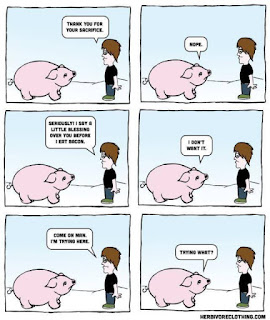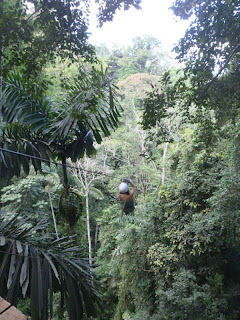10. The restaurants in Puerto Viejo
They were vegetarian-friendly and offered myriad options to free me from the rice and beans that had been my sustenance for a week. I relished vegan coconut French toast, sushi, raw food, iced coffee and cheap cocktails such as the mango daiquiri. The town boasts a vegetarian restaurant, and even the grocery stores had a few items to choose from in addition to the big avocados and mangos available everywhere.
9. Ziplining in the jungle
I’d never been ziplining before, and what better place to do it! It was definitely an adrenalin rush, feeling the wind whipping by as I flew through the treetops. It’s important to “brake” before the end of the line or risk smashing into a tree. Some nice folks in our tour were from Colorado, and the only negative was that I got bitten by little fire ants. I hadn't realized there was a lot of walking required between platforms, and sandals are a poor choice in the rainforest. Ziplining, or canopy tours, were available wherever we went.
8. Tabacón Hot Springs
These were the most luxurious hot springs I’ve ever visited. An eco-friendly and carbon-neutral resort in La Fortuna in the Northern Lowlands, Tabacón is fed from a single hot river. The most well-known luxury hot springs resort in Costa Rica, it is quite expensive. We went at night, which is cheaper and included a pass for the next day. It offers many different pools with waterfalls, beautiful landscaping and a fun slide near the swim-up bar. A friend spent her honeymoon here while watching the nearby Arenal Volcano erupt, although the volcano had been quiet for several months before our arrival. There are other hot springs nearby, including the river that feeds into Tabacón, which is right across the street, beneath a bridge. We ended a rainforest tour there the next day, and it was pleasant except for the roaring current that had us clinging to rocks to keep from being swept downstream along with several annoying children. At least that one was free.
7. Wildlife
Costa Rica's incredible flora and fauna were a primary inspiration for choosing the country as a destination, and it did not disappoint. Walking through the rainforests, we saw all three species of monkeys in Costa Rica—squirrel, capuchin and howler—as well as sloths, coatimundi, a tapir, tropical birds, beautiful frogs, insects and crabs. Wildlife is so abundant, and viewing the animals in their natural habitat, free from cruel captivity, is the only way I ever wish to see them. We even saw a sloth hanging from a power line above the street, although this can be a dangerous place for them.
6. Night rainforest tour
On our first night in the country, my friend and I hired a local guide, who met us at our accommodations in Bahia Drake with rubber boots and headlamps and took us on a walk down the beach and into the forest. He pointed out numerous kinds of frogs, iguanas and insects, including several Brazilian walking spiders, the most poisonous in Costa Rica. These resemble our much more benign wolf spiders, which also hunt their prey on foot. We saw many bioluminescent insects as well and could even spot the glowing eyes of spiders from a distance.
While sloshing through a shallow creek, our guide jumped and stopped short after nearly stepping on a fer-de-lans, the “ultimate pit viper,” which he called the most dangerous snake in the country. Apparently, a bite can kill a person if the victim doesn’t receive treatment within four hours, and we were in the middle of nowhere, with boats as the main form of transport.
Adding to the creep factor were many 3-ft. spider webs surrounding our narrow trail, complete with large red and yellow spiders waiting in the center. I got my hand tangled in one of these. My involuntary scream of pure, mortal terror made our poor guide jump again. Fortunately, the spider didn’t come after me, nor did I tear her web, which was very strong.

5. Luscious weather
It was idyllic for the entire trip, in the mid-80s and clear. It rained just a couple of times over 10 days, and only at night.
4. Kayaking through the rainforest
The river was a short walk from our first accommodations, Hotel Jinetes de Osa in Bahia Drake, and my fun new acquaintances and I paddled a ways down the peaceful river and stopped to swim and then to race kayaks. We were thrilled to see several white-faced capuchin monkeys cross the river above us. The mothers carried their babies and were particularly cautious as they jumped from tree to tree. They were very close, and one jumped down to the riverside near where I had parked my kayak to watch them. He snatched a praying mantis, bit off its head and sucked out the innards.
3. Beautiful beaches
One of the most beautiful beaches I’ve ever been blessed to visit was on the Pacific side of the country in Manuel Antonio National Park, which abuts the rainforest and is known for monkeys on the beach. The turquoise water was the ideal temperature for swimming, with a gentle rocking current and silky light sand. A few large black rocks protruded from the water near the shore. This was a decadently lazy afternoon.
2. The Sloth Sanctuary
We visited the sanctuary in Cahuita, near Puerto Viejo, on our last day in the country before our flight. Greeter sloth Buttercup was very engaged and reached out to us from her swing. I was captivated by the sloths’ peaceful, gentle, low-key, trusting personalities. We arrived too late for a regular tour, but “sloth whisperer” Judy Avey-Arroyo kindly gave us our very own personal tour and introduced us to the adorable babies in the orphanage. Her deep love for and dedication to the sloths were obvious. So much is unknown about these fascinating, threatened animals, and I want to return someday to volunteer. http://www.slothsanctuary.com
1. Jet ski tour with dolphins and whales
Although jet skiing was not on my list of things to do, I begrudgingly took the opportunity when it was discounted for us by a guide after he told us that the sunset sail we were reserved for had been canceled. My friend and I each hopped a jet ski, which were very fun and exciting to drive, and followed our guide into the Pacific off the coast of Manuel Antonio. After miles of speeding along, we were rewarded by seeing dolphins jumping as the sun began to set. Soon after, we spotted a family of humpback whales nearby. I stopped my engine, and the whales glided beneath me. It was so surreal to be in their powerful, peaceful presence as they surfaced and submerged around us. It felt otherworldly and exhilarating. Even though we were only halfway through our vacation, my friend and I agreed that it could've ended right then, and we would've been satisfied.




























